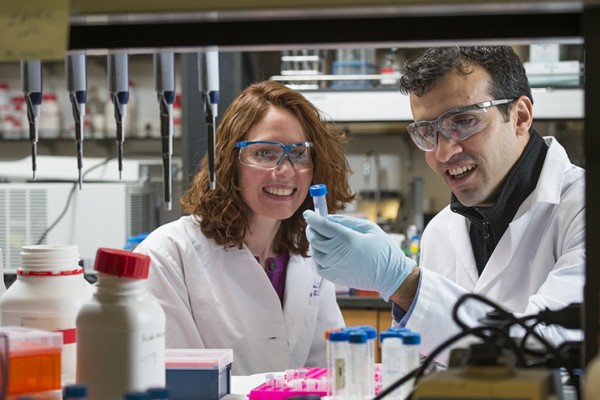It’s not always the DNA
Scientists have mostly ignored mRNA, the molecule that ferries information from DNA to the cellular machines that make proteins, because these DNA transcripts are ephemeral and soon destroyed. But mRNA can be just as
important as DNA scientists at Washington University in St. Louis say. They found that oxidized messenger RNA jams the cellular machines that
make protein. The failure to clear the jams and chew up bad messengers
is associated with neurodegenerative diseases such as Alzheimer’s.
Robert Kranz: a lifetime’s exploration of an important molecule may have a big payoff
Robert Kranz has devoted much of his caeer to understanding cytochrome c, a little-noted molecule but one as important to life as DNA or hemoglobin. Because bacteria and people use different systems to assemble this molecule, his work may open the door to novel antibiotics and other medicinal drugs.
Researchers solve piece of large-scale gene silencing mystery
PikaardA team led by Craig Pikaard, Ph.D., WUSTL professor of biology in Arts & Sciences, has made a breakthrough in understanding the phenomenon of nucleolar dominance, the silencing of an entire parental set of ribosomal RNA genes in a hybrid plant or animal. Since the machinery involved in nucleolar dominance is some of the same machinery that can go haywire in diseases such as cancer, Pikaard and his collaborators’ research may have important implications for applied medical research. Click here for a podcast from Genetic Engineering & Biotechnology News: Interview with Craig Pikaard.
Physics first approach creates K-12 conceptual links
Physics has a reputation for being the toughest of the high school science courses. But visual models of motion, acceleration, waves, projectiles and other principles help students of all ages build an understanding of physical science concepts. For Jack Wiegers, biology instructor, and Patrick Gibbons, Ph.D., professor of physics, these ideas are a key part of science for students from kindergarten through grade 12. The pair instructs four Science Outreach graduate courses in physical science designed for K-8 teachers. They’ve also worked with high school teachers in short workshops and in year-long professional learning communities.
Plant biologist seeks molecular differences between rice and its mimic
Photo by David Kilper / WUSTL PhotoKenneth Olsen, Ph.D., assistant professor of biology in Arts & Sciences, examines a cultivated rice plant in the Goldfarb Greenhouse.Red rice sounds like a New Orleans dish or a San Francisco treat. But it’s a weed, the biggest nuisance to American rice growers, who are the fourth largest exporters of rice in the world. And rice farmers hate the pest, which, if harvested along with domesticated rice, reduces marketability and contaminates seed stocks. Complicating matters is the fact that red rice and cultivated rice are exactly the same species, so an herbicide cannot be developed that seeks out only red rice. It would kill cultivated rice, too. But now a plant evolutionary biologist at Washington University in St. Louis has been funded by the National Science Foundation (NSF) at $1.12 million for two years to perform genetic studies on red rice to understand molecular differences between the two that someday could provide the basis for a plan to eradicate the weed. More…
Effective Partnerships Supporting Genetics and Genomics in the K-12 and Undergraduate Curriculum
The recent revolution in the life sciences- the sequencing of the human genome, and development of “high throughput” technologies- has created new opportunities for investigation, and created new challenges for educators. Sarah C.R. Elgin, Ph.D., professor of biology; biochemistry and molecular biophysics; and education in Arts & Sciences at Washington University in St. Louis, has been a proponent and creator of partnerships locally and nationwide to improve the life science education both in K-12 schools and at the undergraduate level.
Using molecular technique, researchers identify hospital pool bacterial pathogen
A WUSTL researcher has identified a bacterium as the pathogen living on bubbles in hot water environments.A team of researchers, led by an environmental engineer at Washington University in St. Louis, has applied a molecular approach to identify the biological particles in aerosol responsible for making employees of a Colorado hospital therapeutic pool ill. They found: when the bubble bursts, the bacteria disperse, and lifeguards get pneumonia-like symptoms.
Nervous system ‘ears’ line up across from ‘mouths’
Neurons communicate at a synapseAs the nervous system develops early in life, it must create millions of synapses—small spaces between nerve cells across which the cells can communicate. Scientists have long speculated that these synapses are deliberately organized to place the structures that send messages on one cell directly across from the structures on another nearby nerve cell that receive those messages. School of Medicine researchers have provided the first experimental proof of this theory at the level of the nervous systems’ most fundamental unit: individual clusters of structures that send and receive signals.
Nobel Prize recipient Sydney Brenner to discuss ‘Humanity’s Genes’
Nobel Prize-winning biologist Sydney Brenner will deliver the annual Arthur Holly Compton Memorial Lecture for the Assembly Series at 4 p.m. Tues, Oct. 14. The lecture,”Humanity’s Genes,” is free and open to the public and will be held in Graham Chapel, located just north of Mallinckrodt Center (6445 Forsyth Blvd.) on the Washington University campus. Brenner’s lecture will discuss some of the questions raised by the completion of the Human Genome Project. He will talk about both the benefits and the fears raised by recent breakthroughs in genetic research, and his belief that the brain is mightier than the genome.

